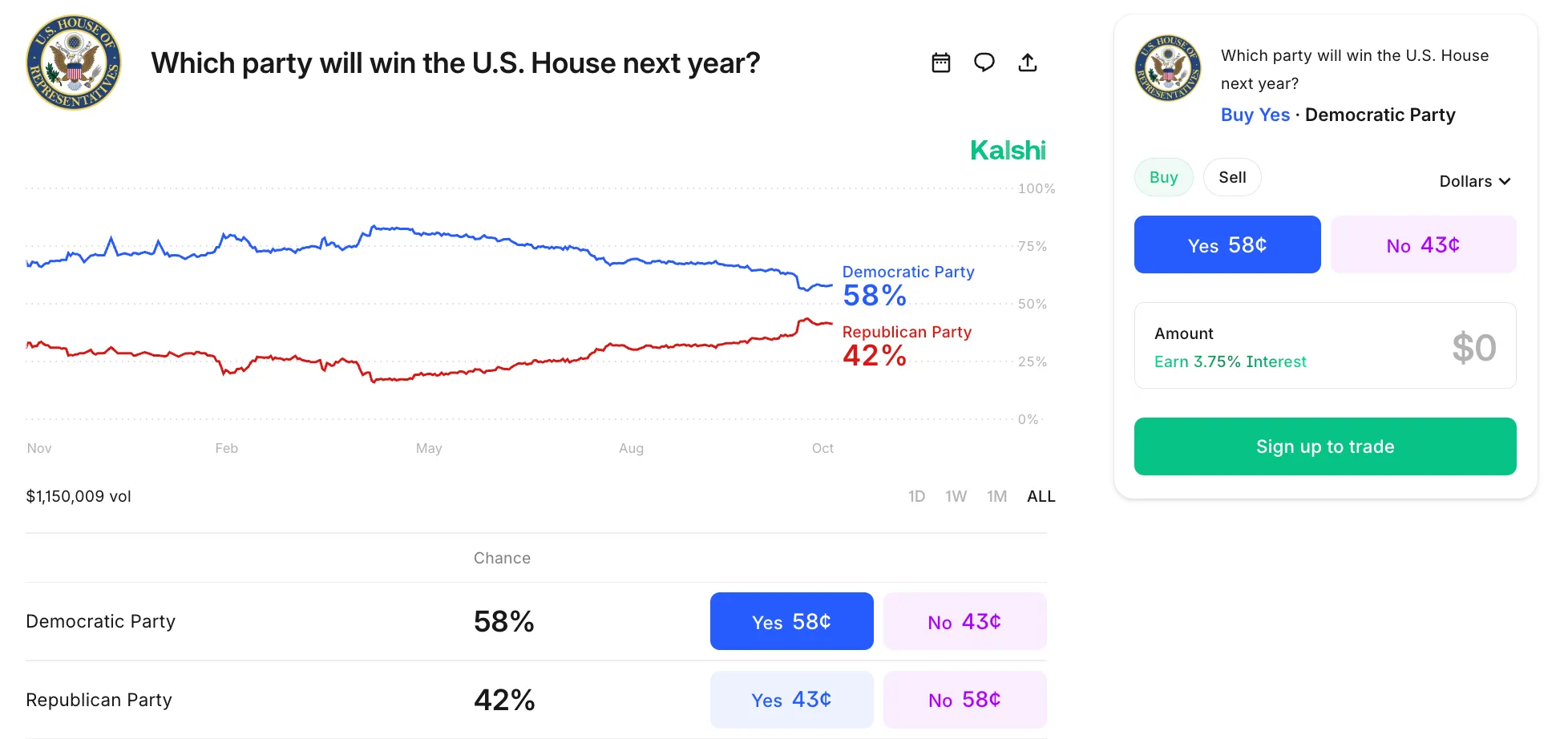Kalshi election markets are Commodity Futures Trading Commission regulated event contracts that let you trade yes or no on political contests. These prediction markets turn polls and commentary into liquid, real-time probabilities the market can use. If you follow politics or you already trade, this will feel familiar: prices move on headlines and order flow.
Let's take a closer look at everything you need to know about the expanding election outcomes markets on Kalshi. If you're interested in learning more about Kalshi and the Kalshi promo code, check out our review!
TL;DR Summary
- Fully regulated exchange for event contracts on election outcomes and other political contests.
- Prices trade between 1¢ and 99¢, with a correct “Yes” settling for $1 per contract.
- Interest has surged into 2025 and the 2026 midterms, with attention on who will control Congress.
How Prediction Markets and Event Contracts Work on Kalshi
Kalshi is an exchange where buyers and sellers meet directly, event contracts trade between 1 cent and 99 cents, and the price reflects implied probability. It's a pretty simple idea: a 68-cent price signals a 68% chance of the outcome. If “Yes” settles true, the payout is $1 per contract.
Prices emerge from participant orders and reflect collective sentiment on predicted outcomes. Therefore, listings span election outcomes, congressional elections, and other political contests such as a government shutdown.
Kalshi is regulated by the Commodity Futures Trading Commission (CFTC), so you’re trading listed contracts on a regulated exchange, not offshore markets. Functionally, these instruments look like derivatives contracts or futures contracts tied to specific outcomes.
- Contracts: Priced in cents that equal probability, settling for $1 on a correct “Yes.”
- Placing Trades: Choose Yes or No, set a quantity, place a limit price.
- Liquidity: You can sell before settlement for a gain or loss, depending on market conditions.
Volume, Accuracy, and Who’s Trading
With the 2025 cycle heating up across the United States and the 2026 midterms a year out, these markets have drawn heavy volume. It's not only speculation, though, as participants from financial markets also use contracts to hedge existing positions, and market makers help keep spreads tight, so you see casual traders alongside pros.
In 2025, political activity on the exchange is on pace to exceed its 2024 presidential election peak, with headline questions such as "which political party will control Congress" accelerating growth. In 2024, these markets usually tracked outcomes more closely than major polls, which is why political outcome trading continues to attract both retail interest and professional hedging.
Active Kalshi Election Markets
As you can imagine from the constant flow of news and data, prediction markets are incredibly busy right now. Kalshi election markets list contracts on everything from who will control Congress to city races that not only get headlines, but also sustains the public interest month after month.
2025 New York City Mayoral Election on Kalshi
This one has been a magnet. The 2025 field opened with 20-plus contenders across the spectrum, and the focus now sits on Andrew Cuomo versus Zohran Mamdani. The final vote is scheduled for Tuesday, Nov. 4.
As of Oct. 31, 2025, nearly $40 million had traded on this market, more than any other 2025 contest on the exchange, and pricing currently leans Democratic at 82% “Yes.” Like most high-profile election markets, movement has tracked headlines, including early reporting around Eric Adams that changed sentiment during the race.
The viral pull of the NYC mayoral market has brought in users who might not typically follow election results, signaling a new era for audience growth and a major win for peers in this space. If the electoral process holds its integrity, interest should keep building, appealing to academic ventures and to investment firms that treat these election contracts as another way to express views and public comment.
Next US Presidential Election Winner on Kalshi
Looking ahead, the “Next US Presidential Election Winner” market is a driver of activity. Traders have moved more than $12 million across nominees and party control contracts. Current VP JD Vance leads at 33% implied probability, with California Governor Gavin Newsom at 22%.
There's also a contract on which political party will win the 2028 presidential election, with “Republican Winner” trading at 52% at the time of writing. If you want to go deeper on candidates, long-shots include Alexandria Ocasio-Cortez at 7%, Marco Rubio at 4%, and Josh Shapiro at 3%.
2026 California Governor Election Winner on Kalshi
California’s 2026 gubernatorial race will draw national attention with Governor Gavin Newsom term-limited. Issues like wildfires and the departure of tech companies keep the race front-page and set up a busy election day.
Unlike federal elections, this one regularly attracts high-visibility names from media and tech. Kamala Harris, Donald Trump, Elon Musk, Xavier Becerra, and Katie Porter have all drawn interest among American traders. Kalshi will offer trading on this market soon, and it should help set the tone heading into the 2028 presidential election as public interest follows the election results.
Other Prediction Markets Kalshi Offers
Beyond the marquee races, Kalshi lists policy and governance questions that trade steadily alongside election outcomes. Here are a few you’ll see on the board:
- Who will be the Republican nominee for Governor in Florida?
- How much government spending will Trump cut this year?
- Will Trump create a National Bitcoin Reserve this year?
- Will Trump impose pharma tariffs this year?
- Will Trump take back the Panama Canal?
- AI regulation becomes federal law this year?
- Congress banned from trading stocks this year?
- How long will the government shutdown last?
These sit next to other political contests and future events that pick up whenever headlines move. If non-political predictionmarkets are more of your speed, you can take a look at markets like Taylor Swift Prediction Markets, GTA 6 Prediction Markets, and Rotten Tomatoes Prediction Markets.
Action Network’s Tips for Trading Kalshi Election Markets
You don’t need a new playbook, just a cleaner one. Use what fits your edge and skip the rest.
- Stay in Your Lane. Focus where you actually know the niche: a state law you track, a lower court decision you’ve read, a district election you follow closely. Settlement relies on official election results, so lean on sources you trust and keep election integrity in mind.
- Trade the News, Not the Echo. In prediction markets, prices move first on primary reporting and public interest, then the echo chamber chases. Size your positions, check liquidity before you enter, and avoid jumping at spikes that look like market manipulation.
- Diversify Across Markets. Spread risk by mixing time horizons and topics, from policy questions to races that could control Congress. Same principle you’d use in sporting events or financial markets: one miss shouldn’t sink the portfolio.
Yes. U.S. users 18+ can open an account and trade after sign-up and ID verification. Availability can depend on state law. You can also propose new markets; if approved, the exchange may offer trading so other traders can participate.
More than 100 election markets across races and policy questions, including 2025 mayoral contests, governor races, and 2026 congressional control. You’ll also see governance topics that move with headlines, plus a smaller set of future events outside core politics. This page focuses on election markets rather than sporting events or other categories.
Yep, the 2028 presidential election is listed. At the time referenced, JD Vance was priced at 42 cents, and a “Republican Winner” political party contract was at 52 cents.
Yes. Uninvested cash can earn up to 4.05% APY automatically via the platform’s partner network. Rates can change.
The 2026 midterms. All 435 House seats and 33 Senate seats are up, alongside key governor races like California. These are federal elections held on election day in November.



